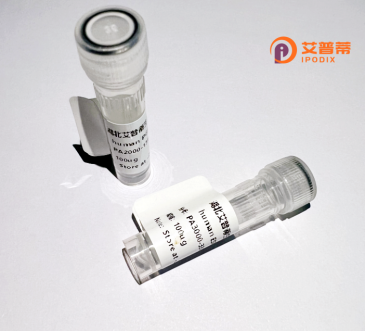
| 纯度 | >90%SDS-PAGE. |
| 种属 | Human |
| 靶点 | SLC35A3 |
| Uniprot No | Q9Y2D2 |
| 内毒素 | < 0.01EU/μg |
| 表达宿主 | E.coli |
| 表达区间 | 1-220 aa |
| 活性数据 | MFANLKYVSLGILVFQTTSLVLTMRYSRTLKEEGPRYLSSTAVVVAELLKIMACILLVYKDSKCSLRALNRVLHDEILNKPMETLKLAIPSGIYTLQNNLLYVALSNLDAATYQVTYQLKILTTALFSVSMLSKKLGVYQWLSLVILMTGVAFVQWPSDSQLDSKELSAGSQFVGLMAVLTACFSSGFAGVYFEKILKETKQSVWIRNIQLVSFSLEPSL |
| 分子量 | 50.9 kDa |
| 蛋白标签 | GST-tag at N-terminal |
| 缓冲液 | PBS, pH7.4, containing 0.01% SKL, 1mM DTT, 5% Trehalose and Proclin300. |
| 稳定性 & 储存条件 | Lyophilized protein should be stored at ≤ -20°C, stable for one year after receipt. Reconstituted protein solution can be stored at 2-8°C for 2-7 days. Aliquots of reconstituted samples are stable at ≤ -20°C for 3 months. |
| 复溶 | Always centrifuge tubes before opening.Do not mix by vortex or pipetting. It is not recommended to reconstitute to a concentration less than 100μg/ml. Dissolve the lyophilized protein in distilled water. Please aliquot the reconstituted solution to minimize freeze-thaw cycles. |
以下是关于重组人SLC35A3蛋白的3篇参考文献及其摘要概述:
---
### 1. **"Functional characterization of the human SLC35A3 UDP-N-acetylglucosamine transporter in mammalian cells"**
**作者**: Ishida N., et al.
**摘要**:
该研究通过重组表达人源SLC35A3蛋白于HEK293细胞中,证实其作为UDP-N-乙酰葡糖胺(UDP-GlcNAc)转运体的功能。实验显示,SLC35A3定位于高尔基体膜,通过调控UDP-GlcNAc的运输影响蛋白质N-糖基化过程。抑制SLC35A3会导致细胞表面糖蛋白表达异常,提示其在糖基化通路中的关键作用。
---
### 2. **"SLC35A3 mutations disrupt nucleotide sugar transport and cause skeletal dysplasia"**
**作者**: Ng B.G., et al.
**摘要**:
本文报道了SLC35A3基因突变与先天性骨骼发育不良疾病的关联。通过构建重组突变型SLC35A3蛋白模型,发现突变体丧失转运UDP-GlcNAc的能力,导致高尔基体内核苷酸糖积累失衡,进而引发糖基化缺陷和细胞外基质蛋白功能异常,解释了骨骼发育障碍的分子机制。
---
### 3. **"Recombinant expression and biochemical analysis of the human SLC35A3 transporter in Saccharomyces cerevisiae"**
**作者**: Martinez-Duncker R., et al.
**摘要**:
研究利用酵母异源表达系统成功重组人源SLC35A3蛋白,并验证其特异性转运UDP-GlcNAc的活性。通过体外放射性标记实验和竞争性抑制分析,揭示了该蛋白对底物的选择性和转运动力学参数,为其在糖代谢中的功能提供了直接的生化证据。
---
以上文献涵盖SLC35A3的重组表达、功能验证及疾病相关性研究,均涉及其在核苷酸糖转运及糖基化中的核心作用。如需具体DOI或期刊信息,可进一步补充关键词检索。
The SLC35A3 protein, a member of the solute carrier family 35 (SLC35), facilitates the transport of nucleotide sugars across intracellular membranes, particularly the Golgi apparatus and endoplasmic reticulum. It is primarily recognized as a UDP-N-acetylglucosamine (UDP-GlcNAc) transporter critical for N-linked glycosylation, a post-translational modification essential for protein folding, stability, and cellular recognition. Encoded by the SLC35A3 gene in humans, this transmembrane protein contains 10 predicted transmembrane domains and is conserved across eukaryotes. Dysregulation of SLC35A3 has been implicated in congenital disorders of glycosylation (CDGs), affecting neurological development and organ function. Recent studies also highlight its role in cancer progression, where altered glycosylation patterns influence tumor invasiveness and immune evasion. Recombinant human SLC35A3 protein is commonly expressed in mammalian or insect cell systems to preserve functional glycosylation motifs, enabling biochemical studies, structural analysis, and drug screening. Mutations in SLC35A3. such as the bovine Q30X mutation linked to hereditary osteopetrosis, underscore its physiological significance. Its interaction with other transporters (e.g., SLC35A2) and regulatory mechanisms, including pH-dependent activity, remain active research areas. Therapeutic targeting of SLC35A3 could address glycosylation-related pathologies or enhance glycoprotein-based biotherapeutics.
×